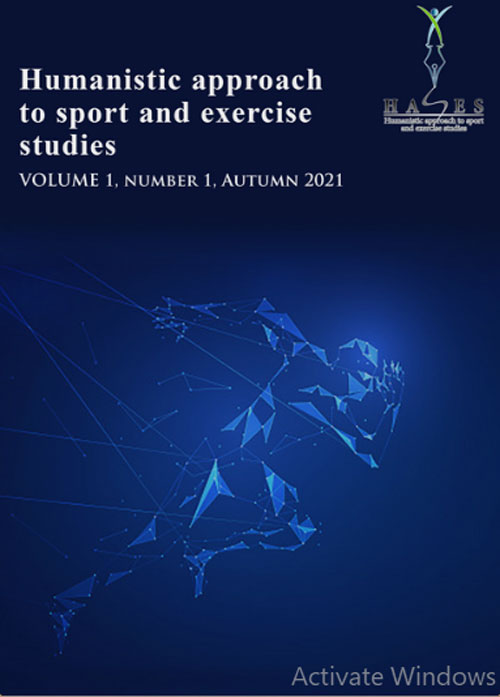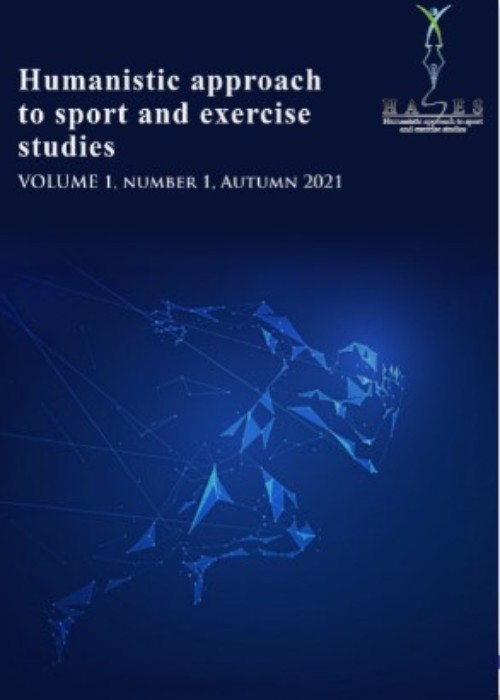فهرست مطالب

Journal of Humanistic Approach to Sport and Exercise Studies
Volume:1 Issue: 1, Autumn 2021
- تاریخ انتشار: 1400/06/10
- تعداد عناوین: 7
-
Pages 1-20
The spread of coronavirus in the world has had various effects on industries, especially the sports industry. The purpose of this study was to explain and classify the effects of coronavirus outbreak on the dimensions of the sports industry. The present study was applied in nature, mixed in terms of data retrieval and descriptive-exploratory in terms of data analysis method that data collection was done in the field. The statistical population in the qualitative section included sports experts, 18 people were purposefully selected, and the statistical population in the quantitative section included all activists in the field of sports and sports industry, of which 600 samples were selected by simple random sampling. Data collection in the qualitative part was done by the systematic method of data theory and in the quantitative part, using a researcher-made questionnaire obtained from the qualitative part of the present study with 79 items in 2 dimensions of direct effects and indirect effects on a 5-point Likert scale. Research data were analyzed using descriptive and inferential statistical methods with the help of SPSS24 and Amos statistical software. The results showed that the outbreak of coronavirus had a direct and indirect role in the production and distribution sectors, private and public sectors, sports education and research, trade, events and competitions, technology, services and economics of the sports industry. This finding can help the country's sports managers and officials to improve the situation of the sports industry in the post-Corona era.
Keywords: Sport, outbreak effects, corona virus, sports industry, trade, sports economics -
Pages 21-29
This experiment assessed the effectiveness of two interventions; mental imagery and physical training as compared to a control group, on their ability to improve visuomotor accuracy, measured by scores achieved on a visuomotor task. For mental imagery participants had to imagine throwing a dart and for physical training participants physically practised dart throwing. Measurements were recorded pre-intervention, after two weeks of training (Mid-intervention), after five weeks of training (Outcome Measure 1) and two weeks after training (Outcome Measure 2). Comparison of Mid-intervention, Outcome Measure 1 and Outcome Measure 2 with baseline showed both interventions to significantly increase performance on dart throwing compared to the Control group. Our findings show that, as well as traditional physical practise, mental imagery can effectively improve performance on a fine visuomotor task. This is an important finding highlighting possible applications of mental imagery in those with limited motor abilities to maintain or enhance motor movement.
Keywords: Imagery, Visuomotor, Athletic Performance -
Pages 30-39
Little research has been carried out on the common symptoms and mental disorders in Iranian elite athletes. The purpose of this study was to identify the mental health problems in Iranian elite athletes as a retrospective study at the National Olympic Academy (NOA) of Iran. The present study is a cross-sectional and retrospective descriptive study which was conducted by evaluating the athletes' psychological documents. A total of 143 athletes (male, n= 83, female, n= 60) were analyzed from the population of elite athletes (n=240) who referred to the mental training and consulting center in the NOA during the years 2007-2021. The results showed that most athletes referred to the center to improve their performance (37.8%). Anxiety (27.3%), depression (16.8%), interpersonal problems (11.2%), impulsiveness (2.8%) post-traumatic stress (PTSD) (2.8%), sleep disturbance (1.4%) were the most common mental disorders reported by athletes. In addition, surveying the relationship between demographic characteristics and mental health issues revealed a relationship between gender and mental health problems; there was no relationship between other demographic variables with mental health problems. The results of this study illuminate the spread of common mental health problems in Iranian elite athletes over the last fourteen years. Screening and diagnosing psychological problems provide a better understanding of the application of appropriate psychological interventions and improving the mental health of elite athletes. Accordingly, future research may focus on better understanding of mental health problems reported in this study and studies them in a larger population.
Keywords: Mental Disorders, Sports, Athletic Performance -
Pages 40-48
The current study aimed to investigate that whether young people with mild intellectual impairments (II) having various levels of IQ have different physical fitness and body composition. Moreover, this study aims to answer this question that is there any association among IQ level, Body Mass Index, and physical fitness factors? A number of 1200 students from all Tehran’s special high schools were screened, and finally, 355 of them with mean age 24.6 ± 3.0 years, height 173.5 ± 6.8 cm, weight 78.6 ± 8.5 kg, and body mass index (BMI) 23.3 ± 2.8 kg/m2 were chosen to be included in the study based on including criteria. All participants had a mild II with the IQ range of 50 to 75 based on the Wechsler Intelligence Test. Participants' physical fitness was assessed by Eurofit special battery test. Body composition evaluation measured by Body Composition Scale. The results showed that there were significant differences in most physical fitness factors between males and females, except in dynamic balance and flexibility (P ≤ 0.05). There was a significant association between IQ levels with all physical fitness factors (P ≤ 0.05) except for flexibility. Different IQ levels were associated with physical fitness factors, so that II students with low IQ had lower physical fitness than those who had higher IQ. Practitioners should consider these differences when working with II people of different gender and different level of IQ.
Keywords: Eurofit, BMI, Intelligence Test, intellectual disability, IQ level -
Pages 49-61
The present study aimed to investigate the relationship between perfectionism and narcissism with psychosocial adaptation in elite and non-elite athletes. A total of 200 elite and non-elite athletes (20-30 years old) who participated in the tournament of 2020 in Tabriz were randomly selected and completed the questionnaire of Sport Perfectionism - 2nd Dun et al. (2009 and 2010), Ruskin and Terry narcissism and Bell Social Adaptation Inventory. To analyze the results, Pearson correlation coefficient and simultaneous regression analysis were used. The results showed that in elite athletes group, there was a positive correlation between positive perfectionism (organizational and personal criteria) and psychological social adjustment, and between negative perfectionism (doubts about actions, perceived pressure of parents and perceived pressure of instructor) and narcissism with negative psychological social adjustment and both positive and negative perfectionism and narcissism variables could significantly predict social adjustment in elite athletes (P <0.05). In non-elite group between positive components of perfectionism, only the organizational component has a negative correlation with psychological social adjustment and the correlation between negative and narcissistic perfectionism components with positive social adjustment is positive. Among the components of perfectionism, the only negative components (too much importance by mistake, parental perception and perceived stress of the mentor) and the narcissistic variable have been able positively to predict psychosocial compatibility (P <0.05). Psychological social adjustment in athletes is one of the key variables in the professional and personal life of athletes, which is influenced by features such as perfectionism and narcissism.
Keywords: perfectionism, narcissism, psychological social adjustment, athlete, elite, non-elite -
Relationship of Narcissism and Coping Strategies with Competitive Stress among Female Elite AthletesPages 62-79
The purpose of this study was to investigate the relationship between narcissism and coping strategies with competitive stress in elite athletes. This research was a descriptive-correlation research method (structural equation modeling). In terms of purpose, the present study was an applied type of research and, in terms of time, was a kind of future research. The statistical population of this study was all elite male and female athletes of East Azarbaijan province in two age groups of youth and adults from team who participated in the championship of 2019. According to the Cochran formula 270 athletes were selected as a sample size. To collect demographic information and measure variables, Individual information form, narcissism and coping strategies in sports competition questionnaires were used. Kolmogorov-Smirnov test (KS) was used to verify the natural distribution of data, Cronbach's alpha coefficient to calculate the internal consistency of instrument, Pearson correlation coefficient to determine the correlation between variables, Confirmatory factor analysis (CFA) was used to study the structural equation modeling and (SEM) models to test the fitting of the base model with the data and to determine the structural relationships between the variables at 95 confidence level, using SPSS22 and Liserl software version 8.53. The results showed that pride had with the greatest impact and the most important role on thought control strategy, imagery, logical analysis, search support, evacuation of unpleasant emotions, distraction of mind and surrender/withdrawal. To be Right had the greatest impact and the most important role on relaxation strategy, efforts to deal with competitive stress in elite athletes.
Keywords: Narcissism, Coping Strategies, Competitive Stress -
Pages 80-92
The purpose of this study was to investigate relationship between coaching leadership behaviors and burnout (physical and emotional exhaustion, feeling of progression and feeling of unworthy) in male athletes. This was an applied and descriptive study. The statistical population of this research was all male athletes in age range of 18-23 (young). A total of 196 athletes were selected by simple random sampling. The instrument of study included two questionnaires: Raedeke & Smith (2001) Athletes 'Burnout Questionnaire and Chelladurai (1998) Coaching Leadership Report. Their internal consistency with Cronbach's alpha for athletes' burnout questionnaire was 0.765 and leadership behaviors of coaches 0.784. Pearson correlation coefficient and regression analysis and SPSS-22 software were used to investigate the hypotheses. A linear model (structural equation) was used to present the model. According to findings of research, coaches are more likely to use behavioral training and less than arbitrary behavior. There was a significant relationship between behavioral training behavior and all scales (physical exhaustion, feelings of depreciation and reduction of progress), between the authoritarian behavior and physical-emotional exhaustion scales, and feeling of progression reduction in scorpion between democratic behavior and a significant positive correlation scale of progress reduction feeling and bu.
Keywords: Coaching Leadership, Behaviors, Athletes, Burnout


